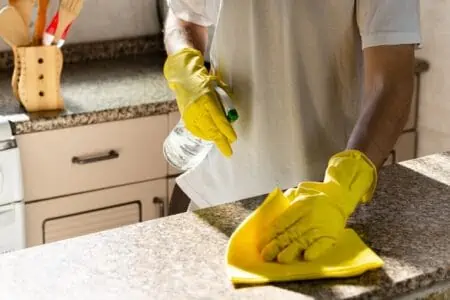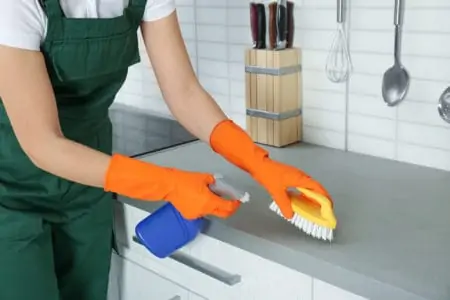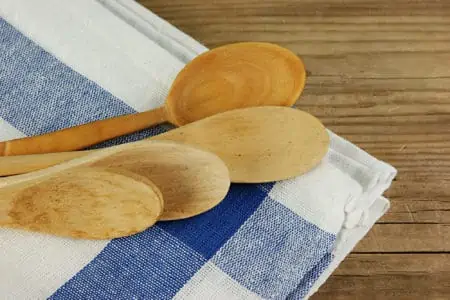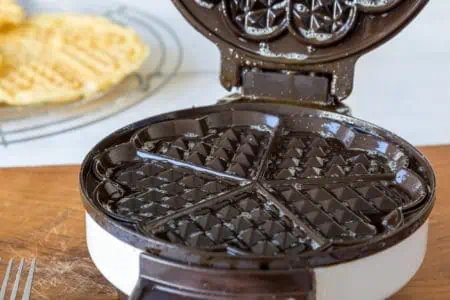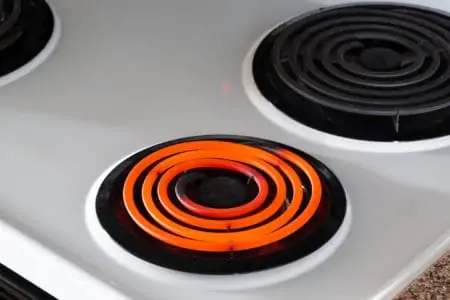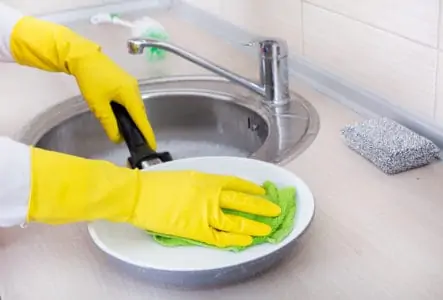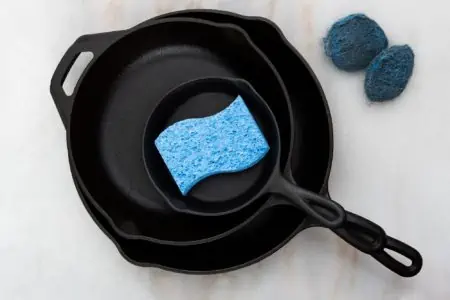Granite is a stunning material to display in your home, but if you leave spills on the surface for too long, it can damage the seal and cause permanent stains.
Thankfully, granite — especially when sealed — is mostly stain-resistant. But if you notice a mess on your granite tops, we’re here to help. We’ll show you how to remove stains from granite, including oil-based stains, ink stains, rust, mold, and more.
Keep reading for the best cleaning methods to bring your granite back to the gorgeous, traditional statement piece it was always meant to be.
Key Takeaways
- Remove oil-based stains with a 1:1 solution of baking soda and water, cover with plastic wrap, and let it sit for three hours before wiping clean.
- For water-based stains, use mild soapy water and a bristled brush, or try a baking soda and hydrogen peroxide paste.
- Clean organic stains like food or coffee spills with hydrogen peroxide or your preferred granite cleaner.
- To remove rust, ink, or paint stains, try hydrogen peroxide or a commercial rust stain remover, but consider a professional for difficult stains.
Are Stains In Granite Permanent?
Naturally, granite is a porous stone. It stains easily, and these marks can be permanent. The good news is that granite, when used in home decor, is well-sealed, causing it to be almost stain-proof.
However, you should still clean up spills immediately. Some stains, especially liquids that can’t evaporate (like oil), can leave behind permanent stains, even on sealed granite.
Overall, granite isn’t as porous as some other stones, so even if you spill oil, hot sauce, or food coloring everywhere, don’t give up. Our methods can help.
What Cleaning Products Are Safe To Use on Granite?
It’s crucial that you use the right products on your granite countertops. We’ll share a list of things you should and shouldn’t use.
Here are a few safe cleaners for granite, including both home remedies and store-bought products:
- Soap and water: One of the best and safest ways to clean granite is mild soap, water, and a soft microfiber cloth.
- Rubbing alcohol: Mix a 1:1 solution of rubbing alcohol and water, and you have yourself a DIY granite cleaner. This is great if you need to disinfect the counter or remove stubborn marks.
- Baking soda: Baking soda works wonders at removing stains, especially oil-based ones.
- Hydrogen peroxide: Hydrogen peroxide is safe to use on granite. Depending on the stain’s severity, you can use anything from six percent to 20 percent hydrogen peroxide. It removes water-based stains, especially when mixed with baking soda.
- Method Daily Granite Cleaner: Getting into commercial products for granite, here’s a great one to have in your kitchen cupboard. This non-toxic granite cleaner is safe to use daily — it will clean and shine your granite, giving it a beautiful polished finish.
- Granite Gold Daily Cleaner: This cleaner is safe for daily use, leaving behind a streak-free finish and a gorgeous citrus fragrance. You can also use it on marble, slate, quartzite, limestone, and other natural stones.
- Weiman Disinfectant Granite Daily: Keep this product nearby if you need to remove 99.9 percent of germs and bacteria. It works in 10 minutes to sanitize your granite counters, tubs, floors, and more.
- Therapy Granite & Stone Cleaner: Clean and polish your granite with this pH-neutral spray. It’s fantastic at removing tough dirt, like grease, grime, and oil.
Here’s what you should avoid:
- Harsh chemicals, like bleach or acid.
- Abrasive scrubbing tools, like steel wool.
- Vinegar, which can dull down and weaken the seal.
- Glass cleaner.
- Formula 409.
How to Remove Stains From Granite
Removing stains from granite is pretty easy, especially when the granite is sealed well. Nevertheless, you might be starting to stress about various stains. We’ll share the best method for removing specific stains, including organic stains, dark spots, and more.
Oil-Based Stains
Oil-based and yellow stains are unsightly, especially in lighter-colored or white granite. Warning: these are some of the most challenging stains to remove.
It’s essential you clean them as fast as you can. But if you’re dealing with an old stain from cooking oil, peanut butter, makeup, or other oil-based products, we can help.
- Make a paste: Mix a 1:1 solution of baking soda and water to create a paste. Adjust the quantities if necessary.
- Apply: Cover the oil stain with the baking soda paste and leave it on for up to three hours. You can cover it in plastic wrap for more severe stains, as this helps adhere the baking soda to the stain better.
- Remove: Scrape off the paste residue with a plastic scraper.
- Wipe: Wipe the area with a damp microfiber cloth.
- Clean the surface: Spritz a stone cleaner — store-bought or DIY — over the stain and clean as usual.
- Dry: Dry the area with a separate microfiber cloth.
Water Marks
Water-based stains, such as those from hard water spills, can be tricky to remove. If your granite is unsealed, the stone can become discolored. But this will disappear when the water evaporates.
If you have hard or heavy water stains, try these tips for removing them:
- Make soapy water: Mix warm water and mild dish soap in a bowl.
- Scrub: Dip a bristled brush into the soapy solution and scrub the stains gently until they have lifted.
- Apply paste: If the stain remains, mix a 1:1 solution of baking soda and water to create a paste. Add an equal amount of hydrogen peroxide and apply it to the stain using your bristled brush.
- Scrub: Scrub the paste into the stain for a few minutes.
- Rinse: Wipe the area with a damp cloth.
- Repeat: If the stain remains, but you can see a difference, repeat steps three and four until the stain is gone.
Organic Stains
Organic stains, like those from food, coffee, and other drinks, are what your granite countertops will have to deal with the most. When you spill these on your countertops, clean them immediately with soapy water or your favorite granite cleaner. If that doesn’t do the trick, try this method:
- Spray hydrogen peroxide: Spray a little bit of six percent hydrogen peroxide directly onto the stained area.
- Wipe: After a few minutes, wipe the area with a damp cloth.
- Dry: Dry the area with a separate cloth.
Warning
Be careful not to bleach the granite with hydrogen peroxide. It’s powerful — so it can discolor darker stones. Test in an inconspicuous spot first.
Ink and Paint Stains
We don’t recommend that you let your little ones do their arts and crafts on a granite surface. But if somebody in the family has spilled ink or paint onto the granite — don’t panic. This cleaning method can help:
- Remove excess paint: Use a plastic scraper to remove excess paint from the granite.
- Prepare cleaner: We will use 20 percent hydrogen peroxide for this method. Put it into a spray bottle undiluted. Keep in mind that this can bleach darker surfaces, so for those countertops, we recommend acetone instead.
- Spray: Spray the stain with hydrogen peroxide or acetone.
- Wipe: Wipe the area with a damp cloth to remove the cleaner.
- Spot clean: If the stain remains, dip a cotton swab in the cleaner and apply it to the ink or paint stain, working in small one-inch sections at a time. Wipe the stain with a damp cloth after a few minutes; we don’t want the cleaner sitting on the granite for too long.
- Repeat: Repeat step five until the stains have been removed.
- Clean as usual: Clean the area with your preferred daily cleaner and a microfiber cloth.
- Dry: Dry the area well.
Rust Marks
We have tons of tips for how to get stains out of granite. But rust stains are a whole other kettle of fish — they can be impossible to remove, especially if the granite is unsealed.
But if your granite is sealed, try this method for eradicating rust stains:
- Spray with hydrogen peroxide: Spray the rust stains using four percent hydrogen peroxide.
- Wipe: Wipe the area with a damp microfiber cloth after a few minutes.
- Dry: Dry well.
If that doesn’t work, you might want to try a commercial rust stain remover for stone. The Tenax TeRust Rust Remover is the most appropriate for rust on granite.
Top Tip
Removing rust stains is hard, but a poultice is perhaps the most effective. We share our tips for how to get stains out of granite with a poultice further down the page.
Mold and Mildew
Mold and mildew growing in your granite is pretty rare, especially if it’s sealed. But if you notice mold and mildew, the most effective thing to do is to call stone cleaning professionals. However, if you want to try cleaning it yourself, we recommend a specialized product, such as DuPont Mold & Mildew Stain Remover.
- Spray: Spray the cleaner on the affected area.
- Scrub: Scrub the area with a bristled brush or non-abrasive sponge.
- Rinse: Rinse the area well with a damp microfiber cloth.
- Repeat: Repeat the above steps if necessary.
Other Dark Spots
Sometimes we come across stains and have no idea what they are or how they got there. Mystery! If you’ve found dark spots or unknown and stubborn stains, there’s still hope.
Try this method for removing them:
- Spray with hydrogen peroxide: Spray the stain with six percent hydrogen peroxide. Don’t forget to test the cleaner in an inconspicuous spot first — we don’t want any discoloration!
- Wipe: Wipe the area with a damp microfiber cloth.
- Dry: Dry the area well.
If this doesn’t work, you can try the poultice method below.
How to Get Stains Out of Granite With a Poultice
We’ve been teasing this method for a while now. What is a poultice? Does it work to clean granite?
A poultice is a cleaning chemical that you can mix with a separate ingredient to create a paste. It will draw the stain out of the granite, removing even the most stubborn of stains. The product you buy will determine what to mix it with; this might be flour, hydrogen peroxide, or something else.
Keep In Mind
Not all poultices need to be mixed. Some are pre-mixed and ready to use. Always follow the manufacturer’s guidelines.
- Time: 20 minutes (plus waiting time).
- Difficulty: Easy.
What You’ll Need
- Stone poultice.
- Mixing ingredient, such as hydrogen peroxide or flour.
- Microfiber cloth.
- Granite cleaner.
- Plastic wrap.
- Masking tape.
- Spoon.
- Sharp knife.
- Container.
- Paper towel.
- Plastic scraper.
1. Clean the Area
Clean the granite using your favorite granite cleaner and a microfiber cloth to remove as much of the stain as possible.
2. Prepare the Poultice
Following the manufacturer’s instructions for your poultice, create a paste. If yours is pre-mixed, you can skip this step.
You want the consistency to be like that of peanut butter, so adjust the quantities until you achieve this.
3. Apply the Poultice
Gently spoon the poultice paste directly onto the stain. Spread it out evenly over the stain. Once it’s settled, cover it with plastic wrap and tape it down.
Make sure to poke a couple of holes in the plastic for breathability. This allows air into the poultice so it doesn’t stay completely damp.
4. Wait and Remove
Leave the poultice on the stain for 24 hours before gently removing it from the granite. A plastic scraper will work great for this.
5. Wipe
Wipe the area with a paper towel to remove the poultice residue. Don’t worry about the stain that the poultice leaves — it’s moisture and will dry after a few hours. Do not use the granite surface until the area is dry.
You should repeat these steps once more to ensure the stains are 100 percent gone.
How to Make a DIY Poultice
Perhaps you want to make your own poultice for removing stains from granite. This might not be as effective, but if you can’t find time to run to the store, this recipe can help.
- Make poultice: Mix baking soda and liquid laundry detergent together to create a thick paste.
- Apply: Apply this to the stained area.
- Cover: Cover the area with damp cloths to keep the solution wet.
- Wait: Wait 24 hours.
- Remove: Wipe or scrape the paste off.
- Wash: Wipe down the counters with your preferred granite cleaner and a microfiber cloth.
You can also make a baking soda paste and cover the stain with plastic wrap. Baking soda works great at pulling stains out of granite, and the added seal will give it even more stain-removing power. Don’t forget to poke a few holes in the plastic wrap so that the poultice slowly dries and hardens.
Professional Granite Stain Removal
If you’re considering hiring a professional to remove stains from your granite, we’ll walk you through some things you should consider. We’ll also let you know what they might do differently than you, so you can determine whether the cost is worth it.
A professional will come fully equipped with the best equipment, the right chemicals, and the most effective techniques. Usually, they use machines with built-in generators that are capable of cleaning various types of stone.
They will use specially formulated stone cleaners. You will want to ask if they can do a deep-cleaning job, though many can offer both deep cleaning and routine maintenance.
Ask them what kind of poultice or paste they use. If it’s something you can buy at the store, you might want to do the job yourself first.
Lastly, they will use specialized techniques. Depending on the type of granite you have and where it is in your home, they can offer various methods. This includes pressure cleaning, re-sanding, brooming between the joints, reapplying sealer, and more.
Some questions you might want to ask the professionals include:
- What’s your specialty?
- What are your credentials?
- Can I see customer testimonials?
- How many years of experience do you have?
- How will you clean the granite and remove my specific stains?
- Do you clean up after the process?
- Are you insured?
- What professional organizations do you belong to?
- Do you have a business license?
Look the professionals up online to find out their reputation and read reviews.
How to Protect Granite From Staining
You know how to remove stains from granite countertops but preventing them in the first place is much less stressful. Here are our top tips for avoiding stains in the future:
- Seal: This is the number one tip for protecting your granite. It must be sealed, or it will surely stain. Granite is naturally porous, so it will absorb stains, and they will set. When you seal granite, the sealer goes into the pores and stops other substances from sneaking in.
- Clean stains immediately: When you spill anything on your granite countertops, clean it up immediately. If you leave it too long — especially red wine, acidic substances, mustard, or chemicals — it can easily leave a stain.
- Daily cleaning: Using a quality granite cleaner, make sure you clean the surface daily. This prevents stains and dirt from building up.
- Nothing abrasive: Don’t use anything abrasive on your granite countertops. Make sure to put down potholders, as dirt on the bottom of hot pans can scratch granite.
FAQs
Keeping Granite Great
Granite countertops are beautiful and, thankfully, easy to maintain. As long as your granite is sealed, stains shouldn’t set permanently. You must clean the surface as soon as possible.
When you have stains, use our various tips to remove them. Whether you have rust, ink, organic or unknown stains, we have plenty of tips and methods to help.
Before you go, don’t forget to avoid certain substances on your granite. This includes bleach, acid, glass cleaner, direct heat, knives, and abrasive cleaners.
